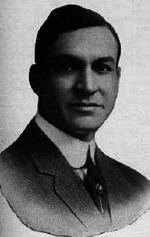Full name Walter George Fovargue Nationality United States U.S. Open T13: 1906, 1916 Turned professional 1899 | Height 6 ft 1 in (185 cm) Masters Tournament DNP The Open Championship DNP Professional wins 1 | |
 | ||
Born October 13, 1882Glenville, Ohio ( 1882-10-13 ) Died 27 March 1963, San Diego County, California, United States | ||
Walter George Fovargue (October 13, 1882 – March 27, 1963) was an American professional golfer, club maker, and golf course architect. In 1916, he was one of the founding members of the PGA of America. He won the 1917 Northwest Open and finished fourth in the 1912 Western Open. He finished T13 in the 1906 and 1916 U.S. Opens and played in the inaugural PGA Championship in 1916 but lost in the first round.
Contents
After 20 years playing as a professional, he applied for and was granted reinstatement to amateur status in 1919.
Early life
Born in Glenville, Ohio, on October 13, 1882, he was the son of Frank P. Fovargue and Augusta E. Fovargue (née Orth). Fovargue started out as a caddy at the Cleveland Country Club and by age 17 was working as a professional there. Due to poor health as a youngster, he was encouraged to get outside in the fresh air to improve his health. He played as both a professional and an amateur during his career. He was described as a person who possessed a "genial manner and sportsmanlike instinct that endeared him to scores of golfers".
Golf career
He replaced Robert Foulis, brother of James Foulis, as the head professional at the Town and Country Club in Saint Paul, Minnesota, in 1900, staying there for a year before moving on to Philadelphia Country Club from 1902–03 and later took a post at the Skokie Country Club outside Chicago.
Fovargue lost a high dollar winner-take-all 36-hole challenge match for $200 against John Reid in 1903 that was played on neutral ground at the Philadelphia Cricket Club. The first prize at the U.S. Open that year was only $150.
In 1908–09 he was posted during the winter months as professional at El Paso Country Club in El Paso, Texas. He was a member of the PGA of America's first executive committee in 1916 while serving as professional at Skokie Country Club, representing the Middle States Section.
He moved to San Francisco in 1916 and established a retail golf sales business. In San Francisco he worked as an understudy with Donald Ross absorbing the latest ideas in golf course construction. In 1917 he moved to Aberdeen, Washington.
In 1918, during World War I, he discontinued his golf career to work in the ship building business at Aberdeen. In 1919 he had his amateur status reinstated after undergoing a one-year waiting period imposed by the USGA. Fovargue considered the ship building job to be "his bit" in the war effort. Fovargue was a competitor in the 1930 British Amateur, played on the Old Course at St. Andrews, Scotland. He lost his match against T. A. Torrance of Great Britain by the score of 5 and 4. Bobby Jones won the tournament, defeating Roger Wethered 7 and 6 in the final.
Golf course architecture
Fovargue was a golf course architect, designing courses in the United States and abroad. In 1921 he designed a course in Japan. He worked in partnership with Wilfrid Reid on courses they built in California.
Selected courses designed
Sources:
Death
Fovargue died on March 27, 1963 in San Diego County, California.
